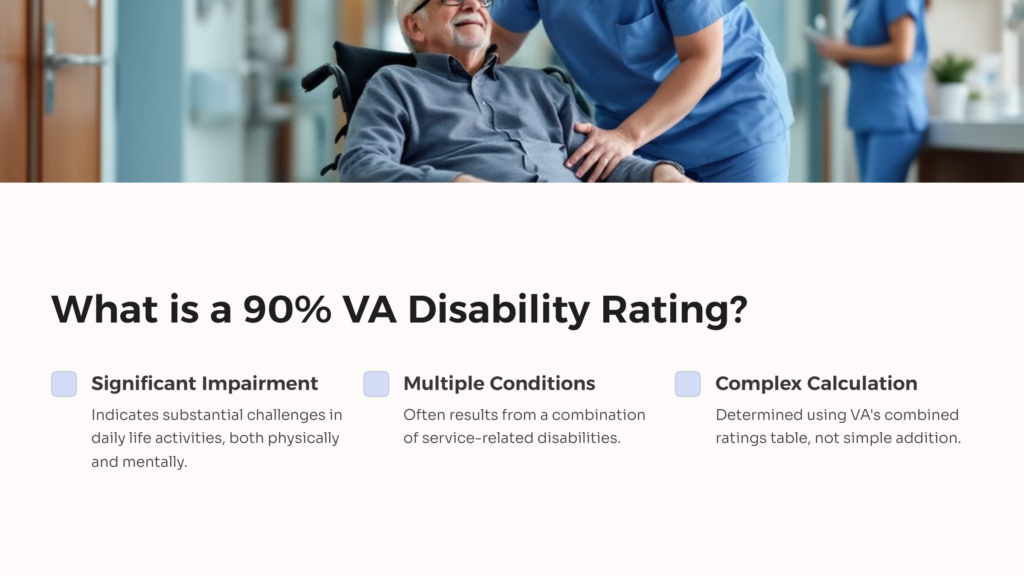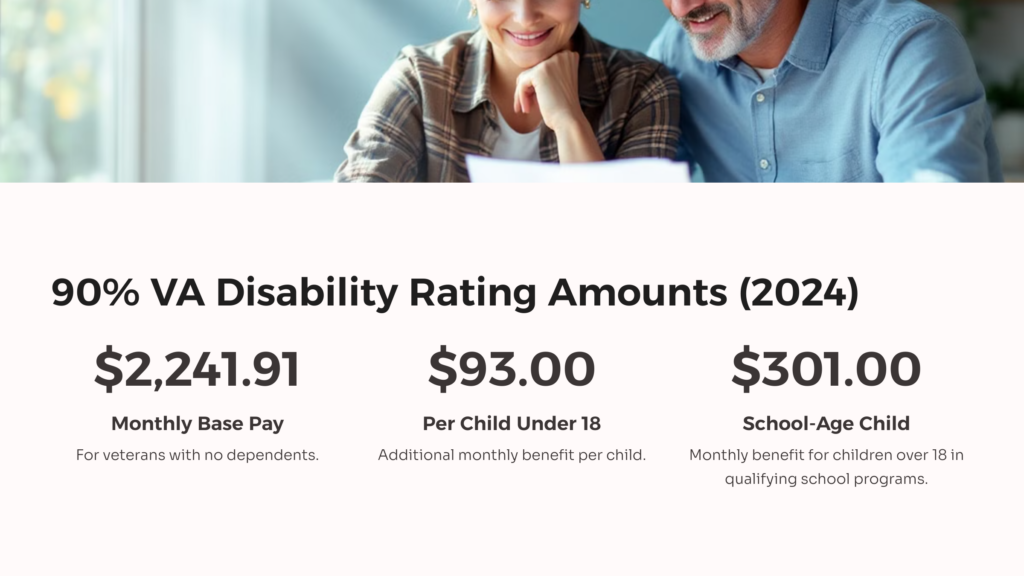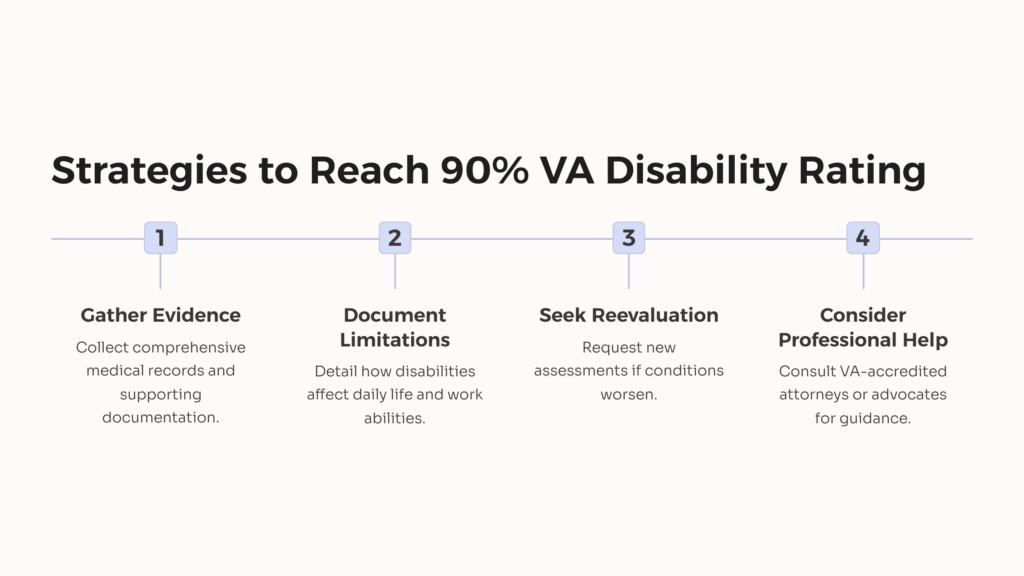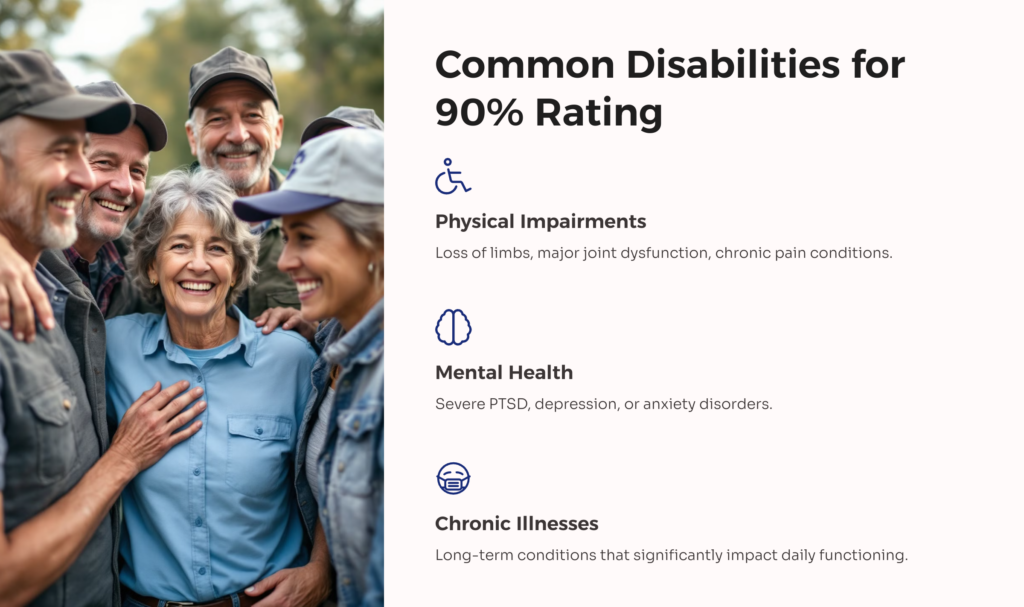Understanding the details of Veterans Affairs (VA) disability ratings is crucial for veterans seeking support for service-related injuries and conditions. Among these ratings is the 90% VA disability rating which could offer substantial benefits and assistance.
Read on to find out what a 90% VA disability rating is, how it compares it to a 100% VA disability rating, and how you might benefit from it.
Understanding 90% VA Disability Rating

A 90% VA disability rating signifies a substantial level of impairment due to service-related conditions. Veterans at this rating experience significant challenges in daily life activities, physically and/or mentally.
Various disabilities could contribute to a veteran being assigned a 90% VA disability rating. These include physical injuries, mental health disorders, and chronic illnesses.
In fact, many veterans are rated for multiple conditions resulting in a higher combined rating that may provide additional compensation.
A combined rating is not merely obtained by adding the individual ratings together. Rather, the VA uses a combined ratings table. A veteran’s disability rating is first determined by the condition that is most disabling followed by less disabling conditions in order of severity.
In order to calculate a combined VA rating, the VA starts with 100%. This represents a whole person. If a veteran has two disabilities that contribute to their VA disability rating, the combined rating will be calculated as follows:
Say the veteran has two disabilities, each rated at 50%. The first disability will rate the veteran as 50% disabled. The second disability will be deducted from the remaining 50% of the whole person. Thus, the second disability will count as 25% (50% of the remaining 50%).
The calculation will look like this:
100% whole person – 50% first disability = 50%
50% remaining of whole person / 2 (50%) = 25%
Combined rating = 50% + 25% = 75%.
To determine a combined rating, the VA rounds up to the nearest 10. Thus a 75% rating would be considered to be 80% total disability.
The same would apply for any additional disabilities.
The VA has issued a ‘Combined Ratings Table’ to assist with calculating the combined disability rating for multiple disabilities.
The impact of a 90% rating on veterans’ quality of life is profound, influencing their ability to work, engage in social activities, and maintain their overall well-being. So, if any veterans qualify for a 90% disability rating, they are entitled to all of the VA disability benefits that come with it.
90% VA Disability Rating vs 100% VA Disability Rating
There are some significant differences between 90% and 100% VA disability ratings. These involve both the eligibility criteria and potential benefits a veteran might receive when assigned their specific rating.
Both ratings offer considerable support. A 100% rating indicates total disability, often accompanied by severe impairments that render veterans unable to engage in substantial gainful employment.
The benefits received by veterans, such as compensation, healthcare, and vocational rehabilitation, vary based on their disability ratings. Circumstances leading to a 100% rating include severe injuries, terminal illnesses, or more than one service connected disability resulting in total incapacity.
90% VA Disability Rating Amounts

The calculation of VA disability ratings follows a meticulous process, considering the severity and impact of service-connected disabilities. At the 90% rating level, veterans receive substantial compensation, reflecting the significant impairment they endure.
This financial support is essential for covering medical expenses, supporting dependents, and maintaining a reasonable quality of life. A comparison of benefit amounts across different disability ratings highlights the incremental nature of compensation, with higher ratings receiving increased financial assistance.
The amount a veteran with a 90% disability rating could receive depends on whether they have any dependents and whether their spouse is eligible to receive Aid and Attendance benefits. The amount of 90% VA disability pay that a veteran receives might change each year.
In 2024, veterans with no dependents will receive $2,241.91 if they have a 90% VA disability rating. The same veterans would receive $7,737.85 if they held a 100% VA disability rating.
Benefits increase if veterans have a spouse and support one or both of their parents.
Veterans with a 90% VA disability rating would also receive $93.00 per month for each child under age 18. For children over the age of 18 who are in a qualifying school program, veterans could receive $301.00.
Similarly, veterans who have a 100% VA disability rating could receive $103.55 for a child under 18, and $334.49 for a child over 18 in a qualifying school program.
Spouses of veterans with a 90% VA disability rating who receive Aid and Attendance benefits would get $172.00. Spouses of veterans with a 100% disability rating will receive $191.14 in Aid and Attendance benefits.
Strategies Towards Reaching a 90% VA Disability Rating

To increase your VA disability rating to 90% and receive 90 percent VA disability benefits, you’ll need to demonstrate significant impairment in multiple areas of functioning related to your service-connected disabilities. Here are some steps you can take to potentially achieve this:
Gather comprehensive medical evidence.
Obtain detailed medical records, including documentation of all service-connected disabilities, treatments received, and their impact on your daily life.
Gather medical records, test results, and opinions from healthcare providers that support your claim for increased disability benefits. This evidence should clearly demonstrate the severity and impact of your service-connected disabilities.
Seek supporting documentation.
Obtain opinions and statements from healthcare providers, specialists, and other experts who can attest to the severity and impact of your disabilities. This may include reports, test results, and assessments that highlight the extent of your impairments.
Document new or worsened conditions.
If you develop new medical conditions or your existing conditions worsen, make sure to seek medical treatment and obtain documentation from your healthcare providers. This documentation should detail the symptoms, diagnosis, treatment, and prognosis of the condition.
Document functional limitations.
Provide detailed information about how your disabilities affect your ability to perform daily activities, work, and engage in social interactions. Document any functional limitations, such as mobility issues, cognitive impairments, or psychological symptoms.
Provide detailed and accurate information.
When submitting a claim for increased disability benefits, provide detailed and accurate information about how your disabilities affect your daily life and ability to work. Be specific about the limitations you experience due to your service-connected conditions.
Submit buddy statements.
Buddy statements from friends, family members, or fellow service members who can attest to the severity of your disabilities and how they affect your life can be valuable supporting evidence for your claim.
Undergo a Disability Benefits Examination (DBQ).
Request a Disability Benefits Questionnaire (DBQ) examination from the VA. This exam allows VA physicians to evaluate the severity of your disabilities and provide medical evidence to support your claim for a higher rating.
Request a reevaluation.
If you believe your conditions have worsened since your last rating decision, request a reevaluation from the VA. Submit new medical evidence and supporting documentation to demonstrate the increased severity of your disabilities.
Consider seeking a VA disability lawyer or advocate.
Consult with a VA-accredited attorney or advocate who specializes in disability claims. They can provide guidance on the claims process, help you gather evidence, and advocate on your behalf to increase your chances of receiving increased disability benefits.
Appeal a decision if necessary.
If your claim for a higher disability rating is denied, you have the right to appeal the decision. Work with your representative to file an appeal and present additional evidence to support your case during the appeals process.
Remember that obtaining a 90% disability rating from the VA can be challenging, and the process may take time. Be thorough in documenting your disabilities and their impact on your life, and don’t hesitate to seek assistance from professionals who can help you navigate the claims process effectively.
Case Studies and Success Stories
Real-life examples of veterans who successfully attained or increased their disability ratings to 90% offer valuable insights and inspiration. These individuals navigated the complexities of the VA system, persevered through setbacks, and advocated for their rights to receive adequate support. Their experiences shed light on effective strategies, such as obtaining expert medical opinions, leveraging supportive documentation, and persistently pursuing their claims. By sharing their stories, these veterans empower others to navigate similar challenges and strive for favorable outcomes.
In conclusion, the journey towards a 90% VA disability rating is multifaceted, requiring perseverance, advocacy, and support. Understanding the nuances of VA disability ratings, comparing benefits between different rating levels, and implementing effective strategies are crucial steps toward achieving or augmenting a 90% rating. By leveraging available resources, seeking assistance from knowledgeable professionals, and advocating for their rights, veterans can maximize their benefits and improve their quality of life.
FAQs about 90% VA Disability
What disabilities commonly lead to a 90% VA disability rating?

Common disabilities that may lead to a 90% VA disability rating include severe physical impairments such as loss of limbs, major joint dysfunction, or chronic pain conditions. Mental health conditions such as severe PTSD, depression, or anxiety disorders can also contribute to a high disability rating.
How is VA disability compensation calculated for a 90% rating?
VA disability compensation is calculated based on the severity of service-connected disabilities and their impact on daily functioning. For a 90% rating, the VA uses a complex formula that takes into account the combined rating of individual disabilities. The compensation amount is then determined according to the VA’s disability compensation tables.
Can veterans with a 90% disability rating work?
Veterans with a 90% disability rating may still be able to work, depending on their individual circumstances and the nature of their disabilities. However, engaging in substantial gainful employment may affect eligibility for certain VA benefits. Veterans should consult with a VA representative or benefits counselor to understand how employment may impact their benefits.
Are there additional benefits available for veterans with a 90% rating?
Yes, veterans with a 90% disability rating may be eligible for additional benefits beyond disability compensation. These benefits may include increased monthly compensation rates, access to vocational rehabilitation services, special monthly compensation for certain severe disabilities, and eligibility for dependent benefits such as Dependents’ Educational Assistance (DEA) or Dependency and Indemnity Compensation (DIC) for eligible survivors.
How can veterans appeal a decision if their disability rating falls short of 90%?
Veterans who disagree with a VA decision regarding their disability rating can appeal the decision through the VA’s appeals process. The appeals process typically involves filing a Notice of Disagreement (NOD) with the VA Regional Office, followed by a series of review stages, including a Decision Review Officer (DRO) review, a hearing before the Board of Veterans’ Appeals (BVA), and, if necessary, further appeals to the Court of Appeals for Veterans Claims (CAVC). Veterans may also submit additional evidence to support their appeal during these stages. It’s advisable for veterans to seek assistance from a VA-accredited representative or attorney when navigating the appeals process.
By taking the first step towards understanding their eligibility and benefits, veterans can access valuable resources and support through AllVeteran.com’s “Get Started” quiz. Empower yourself with knowledge and take control of your VA disability journey today.
 AllVeteran.com Advisors
AllVeteran.com Advisors
With expertise spanning local, state, and federal benefit programs, our team is dedicated to guiding individuals towards the perfect program tailored to their unique circumstances.











